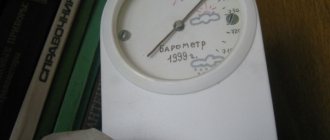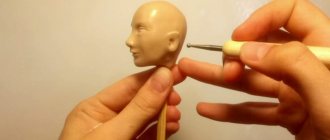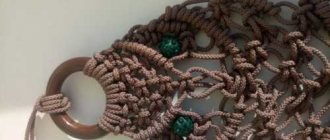The cheapest homemade polymer clay is an order of magnitude cheaper than the cheapest purchased clay (cold porcelain).
How to make such polymer clay with your own hands for 30 rubles/kg without starch, without flour and PVA glue - today’s story on the pages of kamsaddeco.com. You can also watch the video.
How to use a lot of this clay when sculpting a vase head - video.
CONTENT
- Homemade polymer clay and factors that determine its properties.
- Composition and use of homemade polymer clay.
- Homemade polymer clay and its quality.
- The cost of polymer clay (cold porcelain) depending on the components.
- Testing samples made from different polymer clay compositions.
- Conclusion: the cheapest homemade polymer clay without starch and PVA glue.
In the store, self-hardening polymer clay costs from 300 rubles. up to 3000 rub. ($4...40) per 1 kg. The price depends on the manufacturer, seller and packaging volume.
In order to be able to compare the cost of different compositions of homemade polymer clay, we will consider the most popular recipes. Of these, we will determine the most expensive and cheapest components.
Moreover, the requirement must be met - the characteristics of such polymer masses must be approximately the same.
Make your own polymer clay
Polymer clay is an excellent thing for creativity and creating a variety of crafts, toys, and decorations at home. Polymer clay is made from plastic, it is not cheap, and it is a good idea to create it yourself with your own hands. It will be a little different from the store-bought one, but crafts made from it will be just as beautiful and durable.
Do-it-yourself polymer clay, prepared by cooking in a saucepan or cold method, then it will be cold porcelain, from which crafts are also made.
Polymer clay from starch and glue
When making crafts from this clay, you should remember that it dries out a little faster than store-bought clay. She loses about 30% of her starting weight.
Tools:
- PVA glue – 1/2 cup.
- Corn starch - 1 cup.
- Mineral oil – 2 tablespoons.
- Lemon juice – 1 tablespoon.
Preparation method:
- Pour a cup of cornstarch and 1/2 cup of PVA glue into a non-stick pan (do not turn on the heat yet).
- Mix the ingredients until smooth.
- Add lemon juice and mineral oil, mix the mixture well.
- If you want the clay to be a specific color, food coloring should be added at this stage, just a little so as not to change the texture of the clay.
- Turn on the heat, heat the clay over low heat, stirring constantly.
- Stir the clay until it resembles mashed potatoes.
- Remove the pan from the heat.
- Add a little mineral oil to the pan and place the clay on the table. Knead and knead the clay like dough.
- You need to knead the clay while it’s hot; you can wear gloves to avoid burning your hands.
- Knead the clay until smooth, then roll it into a ball.
- Store sealed clay in the refrigerator.
Helpful Tips:
- If you don’t have PVA glue, you can use regular children’s glue for creativity, but then the clay will be more liquid.
- Instead of mineral oil, you can use baby or motor oil (just not jelly-like).
What to do if the clay has spoiled or failed
After prolonged storage in the refrigerator, or due to improper preparation, the clay may turn out to be too dry and inflexible. However, this is not a reason to throw away the product.
- 1 way
It can be saved by mixing it to the required consistency with a new portion of softer polymer clay. Just as during preparation, thoroughly knead the clay until smooth and get to work.
The same method can be used if the polymer clay initially turned out to be too liquid. Mix it with the remains of old dried clay. Or prepare a new one a little drier and denser than usual, and mix it with the liquid portion.
- Method 2
The second method is even simpler, because it doesn’t even require preparing a new portion of fresh clay. You just need to add a little Vaseline or cream to the old mass and also mix thoroughly until the resulting polymer clay is homogeneous.
If your clay has been stored for a very long time and is almost dry, then these two methods are best combined. First you need to give the mass a little viscosity and elasticity by mixing it with soft clay. And then make the mass more pliable with Vaseline.
Make your own polymer clay
The glycerin contained in polymer clay will prevent future crafts from cracking.
Polymer clay made from glycerin and glue
Tools:
- PVA glue – 2 cups.
- Water – 1/4 cup + 100 ml.
- Glycerin – 2 tablespoons.
- Corn starch – 100 grams.
Preparation method:
- Mix PVA glue and 100 ml water in a non-stick pan.
- Boil the mixture for two minutes, stirring constantly.
- Remove the pan from the heat.
- Mix water and cornstarch in a bowl.
- Pour starch and water into a saucepan with glue, mix the mixture thoroughly.
- Pour in glycerin and stir.
- While the dough hardens, it needs to be covered with a lid.
- Sprinkle the work surface with cornstarch, lay out the dough and knead well.
- Knead the dough, adding cornstarch until it stops sticking to your hands.
- Finish kneading the dough when it becomes elastic and soft.
Helpful advice:
- To prevent the dough from drying out prematurely, you can wrap it in cling film and put it in the refrigerator.
Cold porcelain for flowers
Cold porcelain looks very much like polymer clay; beautiful flowers and delicate objects can be sculpted from it.
Tools:
- PVA glue – 1 cup.
- Glycerin – 1 tablespoon.
- Starch - 1 cup.
- Vaseline – 1 tablespoon.
- Citric acid – 1 teaspoon.
- Vanillin.
Preparation method:
- Dilute citric acid in a small amount of water.
- Pour water over the starch, stir and add a little vanillin.
- Pour glue into a separate bowl, add glycerin and Vaseline to it, mix.
- Add starch water and citric acid to a bowl, mix everything until smooth.
- Heat the mixture in the microwave, removing it to stir every 20 minutes.
- Remove the mixture from the microwave when it thickens.
- Cover the table with film, place a lump of the mixture on the surface and begin to knead well.
- Cool the porcelain, then create crafts from it.
- Store in the refrigerator in cling film.
Helpful Tips:
- To prevent the mixture from sticking to your hands when stirring, you can lubricate them with hand cream.
- To paint a finished frozen porcelain product, you need to apply dry food coloring to the figurine and hold it over the steam of a pan or kettle so that the porcelain absorbs the paint on its own.
How to make polymer clay soft
Often in the process of our creativity we have to work with hard polymer clay. They could have sold us something with a long release date. Long-lasting scrap. The brand is too hard. All these are the main reasons for the rigidity of the polymer.
Is it possible to knead the clay so that it is comfortable to work with? Are there any effective ways?
Nothing is impossible. In this article, we will look at all the methods of softening polymer clay in the most detailed way.
Why knead polymer clay at all?
At its core, softening polymer clay is the process of preparing the clay for work.
In most cases, this process is done only by hand. The warmth of our hands, combined with the efforts to stretch and knead the polymer, provides the necessary softness and pliability. The clay begins to change its structure and becomes suitable for modeling. Besides:
- softened polymer clay becomes more flexible and sticky
- the ability to break when bending is eliminated
- you can easily roll it out into a thin layer
- allows you to sculpt more detailed creations.
Some types of clay are so soft right out of the package that we don’t even need to knead them much, they are already ready to work, but this is an exception to the rule rather than a constant pattern. Basically, you first need to knead the clay.
An easy way to knead clay
The simplest, and also the surest way to soften the polymer is to knead it with your hands for several minutes. It is better to take a piece of clay that will be comfortable to hold in your hand and gradually begin to knead it with your fingers. When heated from the warmth of your hands, the clay will begin to soften.
You need to crush and knead a piece of clay for several minutes until the clay becomes plastic.
As a rule, the better the polymer clay is kneaded, the easier it is to create with it. Colors blend better. The individual parts fit together better.
Understanding how long it takes to knead the polymer and the degree of its readiness comes with experience.
The time may vary depending on the type of clay used, the amount of clay used, or the temperature (room or hands). On average, it takes from three to ten minutes to knead clay under normal conditions.
Is it possible to speed up the process of kneading polymer clay?
The process of preparing polymer clay for work can take a fair amount of time and effort, especially if your hands are weak or the clay is very hard. However, there are several ways to speed up this process
You can start softening by placing the polymer in a warm place for 15-20 minutes. Warning: Excessive heat or sunlight will render the clay unusable. The ideal place for preheating is the radiator.
It is easier to work with small chopped pieces by kneading them. By kneading several pieces, they can be combined into larger volumes.
- There is a special thinner for polymer clay on sale - essentially, it is a liquid that, when added a few drops, makes the clay more pliable and soft.
- Mixing with softer clay, adding up to a third of the main volume, will allow you to average the properties of both types. Then knead everything again and knead thoroughly.
- Add a few drops of water. Do not overdo it, otherwise the clay will become unusable.
- It is not advisable to use any other means, for example, Vaseline or greasy cream, as this can only spoil the clay. A visual experiment on softening a polymer using various impurities is in the video below.
Is it possible to overdo it with softening polymer clay?
It happens that by adding too much thinner, the polymer becomes too soft for the technique we want to use. This is also not a problem.
- First, you can let the clay cool slightly by placing it in a cool, dark place or in the refrigerator. Not for long, about 30 minutes.
- Secondly, you can use paper. Having flattened a piece of polymer into a layer, it is placed between two sheets of white paper (without drawings or printed text) and left overnight. The paper will absorb excess plasticizer, and the clay will become a little harder.
Unfortunately, even reanimated polymer clay is sometimes not suitable for the chosen technique. Still, it is better to use fresh, unspoiled polymer.
However, even reconstituted clay can serve well, for example, as a base or individual elements of creative solutions.
How to make polymer clay recipe
Many people think that making this modeling material themselves will not work, this is not so.
Polymer clay made from corn starch
What is necessary:
- 15 grams of fatty cosmetic cream;
- lemon juice a few tablespoons;
- PVA;
- a packet of corn starch;
- You will also need a microwave;
- temperature-resistant glass container;
- cling film or bag;
- plastic spatula.
Now we’ll tell you, as promised, how to make polymer clay at home. We work according to the following steps:
- The first thing you need to pour out is corn powder.
- Pour in PVA and add cream. Mix the ingredients and pour in the juice. Mix well again with a blender or mixer. After mixing, you should have a lump-free mass in front of you. We put it in the microwave for half a minute. The heating temperature should be maximum.
- After the time is up, take the mixture out of the microwave, stir the mixture, and let it cool for half a minute. If a film appears on the surface during the heating process, it must be carefully removed.
- Next, lubricate the surface of the table with cream or Vaseline and spread the mixture. Mix the composition well, just like you do with dough. Kneading time is about five minutes.
- All is ready. If necessary, the finished substance can be painted in any suitable color. For this, a variety of paints are used.
Now you know how to make polymer clay at home. The manufacturing process is not that complicated, and only takes ten minutes of your time.
How to make polymer clay without cooking
Many people are interested in how to make polymer clay at home without heat treatments. This question is relevant, since heating in a water bath or in a microwave is inconvenient for many and the process requires following safety precautions.
Manufacturing without heat treatment
The recipe for preparing polymer clay in a cold version is practically the same in the technology for making the composition, but it differs in some ingredients.
To prepare this recipe, you must have:
- corn starch one package;
- PVA;
- one tablespoon of Vaseline oil;
- two large spoons of Vaseline (or replace with hand cream);
- 20 grams of perfume.
Having collected all the components, you can begin manufacturing. By the way, in this case you can involve your child, it is quite safe, just like the modeling itself.
- Pour glue into the selected container, add petroleum jelly and, if desired, perfume. Mix the composition.
- Next, add a little starch and mix the material. While mixing, add corn powder. Mix thoroughly. Add fatty cream (if it is not there, replace it with Vaseline).
- Mix everything and pour out the rest of the starch. Now mix the mixture thoroughly. You can add watercolor paint and get the desired color.
So you learned how to make polymer clay at home without needing to heat or cook anything. To make sure that unusual things can be made from the material produced, for example, very beautiful jewelry or dolls.
Polymer clay from soda and starch
- 1 part baking soda;
- 1 part cold filtered water;
- 1 part corn starch (if replaced with potato starch, the color will be gray).
This mass is perfect for beginners. It is easy to prepare and easy to sculpt.
- Mix the ingredients in a thick-walled saucepan.
- Cook the mixture over medium heat, stirring continuously until it thickens.
- Place the finished mixture from the pan onto a silicone mat and cover with a slightly moistened towel. Wait until it cools down a little.
- Knead the mass vigorously until it becomes sufficiently elastic and suitable for modeling.
Polymer clay from glue with glycerin
- 400 g of PVA wood glue (wood glue);
- 180 g water;
- 200 g starch (preferably corn starch);
- 40 g glycerin;
- dyes if necessary.
Products made from cold porcelain according to this recipe dry within half an hour. But before using it, you need to let it rest.
You can wait overnight, or better yet, keep it in the refrigerator for a week.
- Combine glue and 100 g of water in a thick-walled or non-stick pan. Place over medium heat and cook for about 2 minutes. Remove from stove.
- In a clean container, mix the starch with the remaining water and pour into the still hot mixture. Mix everything well until smooth.
- Cover the mixture with a towel and leave until cool.
- When the mass has cooled sufficiently, place it on a table surface sprinkled with starch. Knead the mixture with your hands, adding starch if necessary.
- When the cold porcelain becomes smooth and elastic, transfer it to a dry container with an airtight lid.
The sequence of making a mass based on potato starch
Polymer clay according to this recipe is prepared as follows:
- Mix all ingredients in a smaller bowl.
- Pour an arbitrary amount of water into a large container so that the smaller one placed in this one ends up in the water, but stands at the bottom and does not float.
- Mix the mixture thoroughly and do not overheat it.
- When lumps begin to form, remove from the heat and place on a surface greased with cream and continue kneading (if the mass is not overheated, your hands should not be hot).
- When the surface of the clay becomes smooth and no wrinkles form, wrap the mass in film and leave for 12 hours.
After this, you can begin sculpting or put the clay away for storage.
Self-hardening paste recipe
A popular polymer clay recipe often used for crafts in Latin America.
Tools:
- PVA glue – 1 cup.
- Water – 1/2 cup.
- Corn starch - 1 cup.
- Glycerin – 1.5 tablespoons.
- White vinegar – 1.5 tablespoons.
- Cold cream with lanolin – 1.5 tablespoons.
Preparation method:
- In a heavy-bottomed saucepan, combine half a cup of water with 1 cup of cornstarch.
- Heat the mixture over low heat until the starch has dissolved.
- When the starch has dispersed, add PVA glue.
- Add 1.5 tablespoons each of white vinegar, cold cream and glycerin.
- Heat the mixture over low heat until it begins to pull away from the sides of the pan and takes shape.
- Place the clay on a flat surface and knead it well with your hands.
- Cover the clay with a damp cloth and let it cool.
- When the dough becomes homogeneous and smooth, it is ready to use.
- Store in a cool, dark place in an airtight container.
Helpful Tips:
- When the dough begins to pull away from the walls of the pan, it should be immediately removed from the heat; if it overheats, it may become excessively hard.
- Glycerin can be purchased in the baking department.
General recommendations
- The basis of homemade plastic mass (it is often called cold porcelain) is glue. It is advisable to use a white composition, since adding the appropriate dye to it is quite simple. The most suitable product for these purposes is PVA for working with wood.
- For the production of polymer clay (which sticks well), cookware with a non-stick coating is best suited. But it is unlikely that it will be used for cooking later. The author advises for these purposes to choose a cheap old saucepan, for example, an aluminum one. Then it won’t be a shame to throw it in a landfill. Or adapt a metal jar by attaching a handle to it, which can be easily made from thick wire (as an option).
- Storing homemade polymer clay is easy to organize. The main thing is to exclude access to oxygen. For example, place the warm mass in a thick plastic bag. As soon as its temperature reaches room temperature, wrap the resulting lump tightly in polyethylene, squeezing out any remaining air, and seal it tightly.
- When working with polymer clay, you should periodically lubricate your hands with an appropriate cream. This way it will practically not stick, and kneading and leveling it is much easier.
Durable polymer clay
Do-it-yourself polymer clay using this recipe will turn out to be very durable; if you drop a craft made from it from a height of 1 meter, it will not break.
Tools:
- PVA glue – 1 cup.
- Stearic acid – 0.5 tablespoon.
- Citric acid – 0.5 tablespoon.
- Vaseline – 1.5 tablespoons.
- Glycerin – 1.5 tablespoons.
- Corn starch - half a glass.
Preparation method:
- In a non-stick pan, mix half a tablespoon of citric and stearic acid, petroleum jelly and glycerin, and PVA glue.
- Place all ingredients on low heat.
- Gradually add cornstarch to the pan, stirring continuously.
- Knead the clay until it begins to separate from the sides of the pan, even when it becomes difficult to do so.
- Place the clay on a flat surface and knead with your hands for 20 minutes.
During the sculpting process, the clay should become smooth, not sticky and without lumps.
If after kneading the clay is still a little hot, let it cool, then pack it in a sealed bag, releasing all the air from it.
Helpful Tips:
- It is recommended to sift the starch before adding it and add it little by little to avoid lumps forming.
- Before making crafts, the clay must dry for at least three days.
Cold porcelain without cooking
A plastic material that is well suited for modeling dries within 1 – 2 days.
Tools:
- Vaseline – 1 tablespoon.
- Starch - 2 tablespoons.
- Baking soda – 10 grams.
- PVA glue.
Preparation method:
- In a bowl, grind Vaseline and starch together until smooth.
- Add a little baking soda and stir the mixture.
- Add PVA glue gradually, 1 teaspoon at a time, until the mass becomes soft.
- Mix the mixture well and place on a table sprinkled with starch.
- Lubricate your hands with Vaseline and knead the mixture until it becomes homogeneous and plastic.
Helpful Tips:
- You can add sparkles and glitters to cold porcelain to diversify the color palette or mix two portions of different shades.
- If you use potato starch, the clay will be denser; if you use corn starch, you can subsequently mold the workpiece thinner and its elements will be more transparent, which is good for creating flower petals.
Pros and cons of homemade clay
Products made from homemade clay are practically no different from products made from purchased clay. It has quite a lot of advantages:
- products made from it dry from 30 minutes to 24 hours depending on the size of the product;
- the ingredients for cooking are not very expensive and are found in almost every home;
- finished crafts can be painted with acrylic or gouache paints;
- prepared clay can be stored in an airtight container in the refrigerator for quite a long time;
- the products are neat and retain their shape well;
- finished products are durable and can be stored for a long time in dry rooms.
But it has some disadvantages:
- preparing it is quite long and difficult;
- it may not work out the first time;
- not any glue is suitable for making polymer clay;
- the result may not always meet expectations;
- products may crack or dry out;
- During cooking, you can damage the dishes.
Polymer clay, prepared at home, is ideal for creative activities with children or creating small amateur crafts. But if you want to create jewelry professionally, then it is better to use purchased polymer clay.
It has a convenient consistency and makes more accurate crafts.
Reasons for poor quality crafts
We figured out how to make polymer clay at home, but often in the process of sculpting from this material, the finished products quickly deteriorate. In this case, everyone blames the wrong recipe for preparing the material, but in reality this is not the case.
Such qualities are influenced by many factors, including errors that were made during the design of the figures.
Incorrect timing
This factor contributes to the violation of the properties of the manufactured material. As everyone knows, during the process of baking a product in the oven, plasticizers are released from the main composition, and thus the clay craft becomes hard.
If the material is not baked, the tenacity will be weak and the finished craft will begin to break.
Therefore, experts recommend baking each layer of clay for 20 minutes, so that all the plasticizer will evaporate from the material and the product will become strong. If the time is not the same, the finished product will be fragile and will quickly break.
Incorrect temperature selection
A polymer clay craft that is baked at the wrong temperature becomes fragile after completion. Experts recommend observing precise baking temperatures in this process.
Also note that most kitchen stoves with ovens have a thermometer installed, which has an error in the readings.
Basically, the readings differ by 10-20 degrees. Of course, for preparing delicious dishes these indicators are not critical, but for clay crafts these indicators will carry a large error.
Experts recommend using a special thermometer. Its readings will be more accurate, this is important for finished products.
It is also recommended to allow the product to cool on its own after baking. Do not take the craft outside or water it with cold water.
By following these rules for making crafts from manufactured polymer clay, all items will be of high quality.
Processing irregularities
Often, finished crafts begin to break after heat treatment. Many in this case, sin on low-quality base material. Of course, another mistake could be the cause of the breakdown, but still mistakes were made during processing.
When processing the material, do not act on the product with brute force, and you will succeed.
Why are products rejected?
Often, figurines sculpted from polymer clay quickly become unusable. Many people blame the recipe for this, but the recipe has absolutely nothing to do with it.
We recommend reading:
A paper crown is a simple instruction for creating original jewelry with your own hands. Templates, diagrams, master class, exclusive design (110 photos)Weaving from newspaper tubes for beginners: the best free master class, with step-by-step instructions. Photos, diagrams, unusual ideas, videos
- Paper rose - how to make it yourself? Step-by-step instructions, original ideas, photos, videos, master class
The quality of the product depends on a large number of external and internal factors and errors made during the manufacture of the craft.
Let's consider the influence of some factors in more detail.
Improper storage
The last reason affecting the quality of finished polymer clay products is considered to be improper storage conditions of the material. You should not store prepared polymer clay in the sun, and it is also not recommended to store manufactured items in the sun.
During such storage, the ingredient that is responsible for the adhesion of the material evaporates.
It is advisable to store the finished substance in an airtight container, which will be placed in the refrigerator. Plastic containers or plastic bags can be used as such an item. But you should not completely close the container; when closed, the clay may dry out, unless, of course, it is used immediately after production.
If polymer clay and the craft itself were made in compliance with all requirements, you can use it without fear that it will break. This product can withstand being dropped on the floor and will serve you for a long time.
As you have seen, making polymer clay at home is not at all difficult, just like making various crafts from it. The main thing during production is to comply with all requirements.
Colored plasticine
Children are not interested in sculpting with clay unless it is colored in different colors. To color the material, there are two options:
- Paint the finished product.
- During the preparation of clay, dye is added.
When the toy is dry, it is additionally coated with acrylic paint. The white areas of the craft are primed because the material looks transparent when unpainted. When adding dye to clay, be careful not to overdo it. Food-grade, acrylic or aniline paints are used to color plasticine. If you add a lot of dye, the structure of the material and its properties will change.
Storage conditions
The composition of polymer clay may include various ingredients, so the preparation requires correct storage conditions. All recipes differ from each other not only in ingredients, but also in manufacturing technology. It is important to properly prepare plasticine and store it efficiently until the moment when it will be used for creative crafts. Regardless of the recipe, the composition is kept in the refrigerator.
First it is wrapped in a paper bag and then in a plastic bag. You can use a plastic container instead. If the composition has not completely cooled down after cooking, a small gap is left between the bottom and the lid of the container. If the plasticine is in a bag, it does not need to be completely tied. When the clay has completely cooled, the bag is tightly tied and the container is closed, otherwise the plasticine will dry out.











